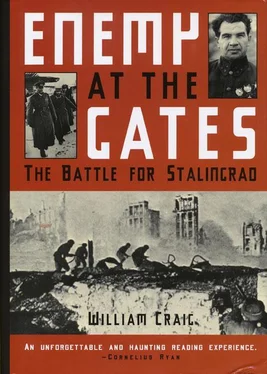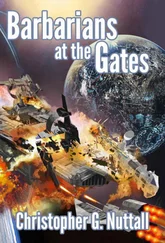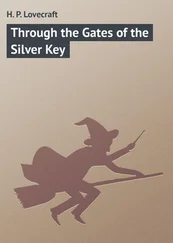No one realized it at the time, but this decision to “stand fast” would change the course of history.
A few days later, on the night of August 1, Stalin had made another attempt to strengthen Stalingrad. Near midnight a Red Army staff car pulled up to the entrance of the Kremlin’s private quarters, and a squat, gray-haired officer eased slowly out of the back seat to limp painfully into the building. At the door to the premier’s office, forty-nine-year-old Gen. Andrei Ivanovich Yeremenko put down his cane, braced himself, and walked briskly into the room.
Stalin greeted him warmly. Shaking Yeremenko’s hand, he asked, “Do you consider yourself recovered?”
Yeremenko said he felt fine. Another general interrupted, “It looks like his wound is still bothering him, he’s limping.”
Yeremenko shrugged off the remark, so Stalin let the matter drop. “We shall consider that Comrade Yeremenko has fully recovered. We need him now very badly. Let’s get down to business.”
Stalin spoke to the point. “Due to the circumstances around Stalingrad, prompt action must be taken to fortify this most important sector of the front…and to improve control of the troops.” Stalin went on to offer Yeremenko command of one of the fronts in the south. The general accepted, and Stalin sent him to STAVKA Headquarters a few blocks away to be briefed about the situation on the steppe.
Yeremenko spent the better part of August 2 studying the maps of Stalingrad and the surrounding area. As he stared at the topographical details of the forty-mile strip of land between the Don and Volga rivers, he concluded that in order to attack Stalingrad the Germans would have to concentrate most of their strength in that narrow “bridge” where the Don and Volga come closest to each other. And he wondered whether that type of deployment might offer the Russians a chance for a successful counterattack from the flanks.
After selecting the nucleus of a staff, he went back to Stalin for another conference. This time, the premier seemed more nervous and preoccupied. Puffing absently on his pipe, Stalin listened while his army chief of staff, Marshal Alexander Mikhailovich Vasilevsky, briefed him on the day’s activities. When the marshal concluded, Stalin turned to Yeremenko and asked: “Is everything clear to you, comrade?”
Yeremenko spoke up against the idea of two Russian fronts in the same region, especially since their boundaries met in the exact center of Stalingrad. To him, trying to coordinate the defense of a city with another commander equal in responsibility would be “utterly confusing, if not tragically impossible.”
Stalin left at that point to take some phone calls from the south. When he returned, he was subdued and obviously worried. Picking up Yerernenko’s protests about dual fronts, he said firmly: “Leave everything as it was outlined….” Stalin told Yeremenko to take over the Southeastern Front and hold back the German Fourth Panzer Army coming toward the Volga from Kotelnikovo. Unhappy with this assignment, the general asked if he could lead the Stalingrad Front, comprising the northern part of the city and beyond to the Don, because he wanted to attack the German flank in that region.
Stalin broke in brusquely, “Your proposition deserves attention, but in the future… now the German offensive must be stopped.” Stalin had sounded annoyed and when he paused to fill his pipe with tobacco, Yeremenko mended his fences by agreeing with his commander in chief. As Stalin saw him to the door, he warned Yeremenko to take drastic measures to enforce discipline at the front. Now, on the night of August 5, Joseph Stalin paced his office waiting for further news from the steppe. Yeremenko had phoned from Stalingrad. He had sounded optimistic, but Stalin knew that sixty miles to the southwest, German tanks were brushing aside scattered Russian resistance and charging toward the city.
Unless Yeremenko stopped them, Stalingrad would fall in a few days.
The city that Hitler had never planned to capture, and that Stalin had never intended to defend, lay sweltering under the summer sun. No rain had fallen for two months and, day after day, the temperature soared well above one hundred degrees. Worse, the humidity that typifies a river town was totally enervating. When the wind blew, it always came from the west—hot, dusty, bringing no relief. The citizens of Stalingrad were accustomed to being uncomfortable and they joked about how the heat made the concrete sidewalks bulge and buckle upward, splitting the slabs into giant fragments. As for the shiny asphalt roads, all one could do was watch the mirages rising from the wide boulevards in the center of town.
Few people in this cauldron knew their city was about to become a battlefield, but the tragedy of war had always menaced the region. In the year 1237, the Golden Horde of the Great Khan had crossed the Volga at this perfect fording point, ravaged the territory, galloped on to the Don, and then swept westward into European Russia, stopping their invasion just short of Vienna and the Polish border. During the thirteenth and fourteenth centuries, Moscow began her own expansion into Asia; the region became a border post from which Russian soldiers sallied forth to fight the Mongols. When the czar decreed the area safe for settlement in 1589, he established a trading center called Tsaritsyn. In Tartar language the name was pronounced “sarry-soo” and meant “yellow water.”
Though the location was safe enough to settle, it never knew peace. Russian brigands wreaked havoc on the citizenry as they plundered their way north and south along the length of the Volga. The geographical key to bringing the wealth of the Caucasus to Moscow and Leningrad, the heartland of Russia, as well as being the east-west gateway to Asia, Tsaritsyn was a place for which men would always do battle.
The legendary cossack leader, Stenka Razin, took the city in 1670 and held it during a bloody siege. Just over one hundred years later, another cossack named Yemelyan Pugachev, decided to challenge the power of Catherine the Great and stormed Tsaritsyn in an effort to free the serfs. The rebellion ended as could be expected. The czarina’s executioner cut off Pugachev’s head.
Still the city prospered, finally taking its place in the industrial revolution when, in 1875, a French company built the region’s first steel mill. Within a few years, the city’s population had grown to more than one hundred thousand and, during World War I, nearly one-quarter of the inhabitants were working in its factories. Despite the boom, the city reminded visitors of America’s wild west. Clusters of tents and ramshackle houses sprawled aimlessly along the riverbank; more than four hundred saloons and brothels catered to a boisterous clientele. Oxen and camels shared the unpaved streets with sleek horse-drawn carriages. Cholera epidemics scourged the population regularly as the result of mountains of garbage and sewage that collected in convenient gullies.
It was almost predictable then that the Bolshevik Revolution would bring Tsaritsyn to its knees. The fighting for control of the region was unusually bitter and Joseph Stalin, leading only a tiny force, managed to hold off three generals of the White Anny. Finally driven from the city, Stalin regrouped his forces in the safety of the steppe country, fell on the flanks of the White Army in 1920, and won a pivotal victory in the revolution. To honor their liberator, a jubilant citizenry renamed the city Stalingrad, but words alone could not repair the damage wrought by war. The factories had been rendered useless, famine struck down tens of thousands, and Moscow decided the only way to save the area was to return it to its industrial state. It was a wise decision. The new industrial plants soon were exporting tractors, guns, textiles, lumber, and chemicals to all parts of the Soviet Union. During the next twenty years, the city grew by leaps and bounds along the high cliffs of the western bank of the Volga. Now half a million people called it home.
Читать дальше












